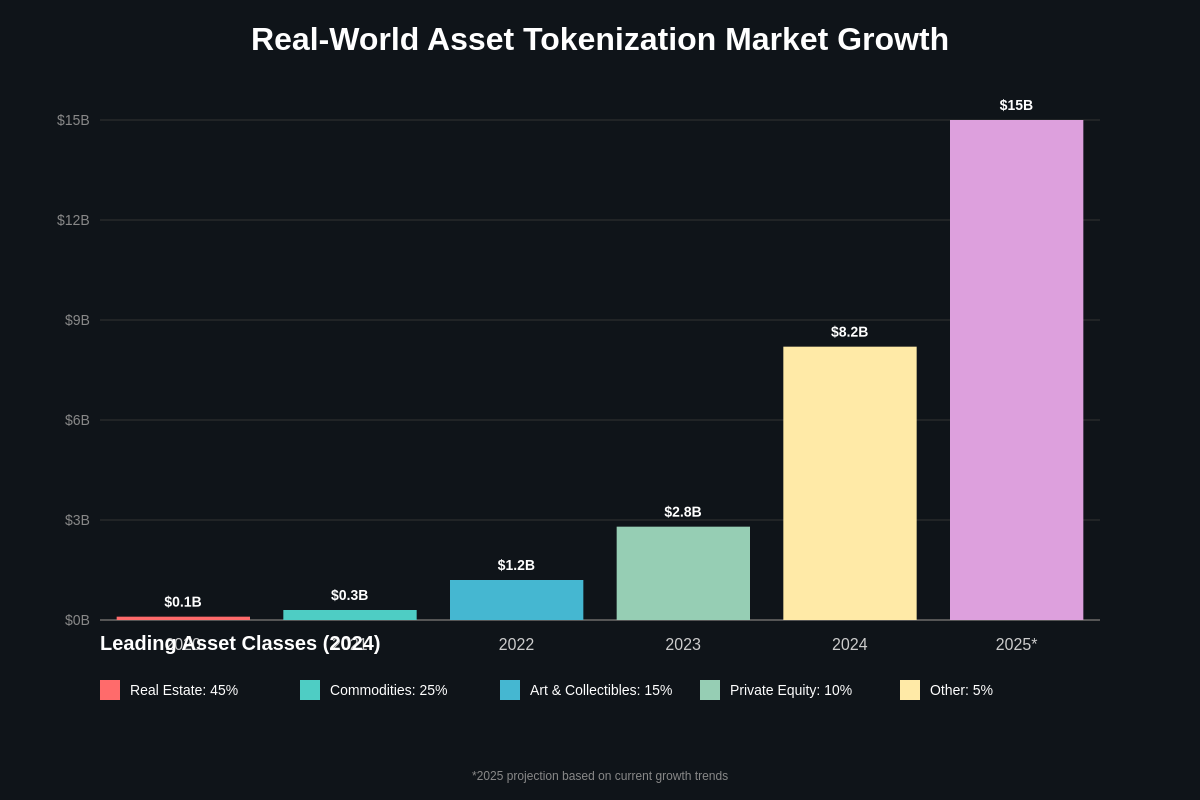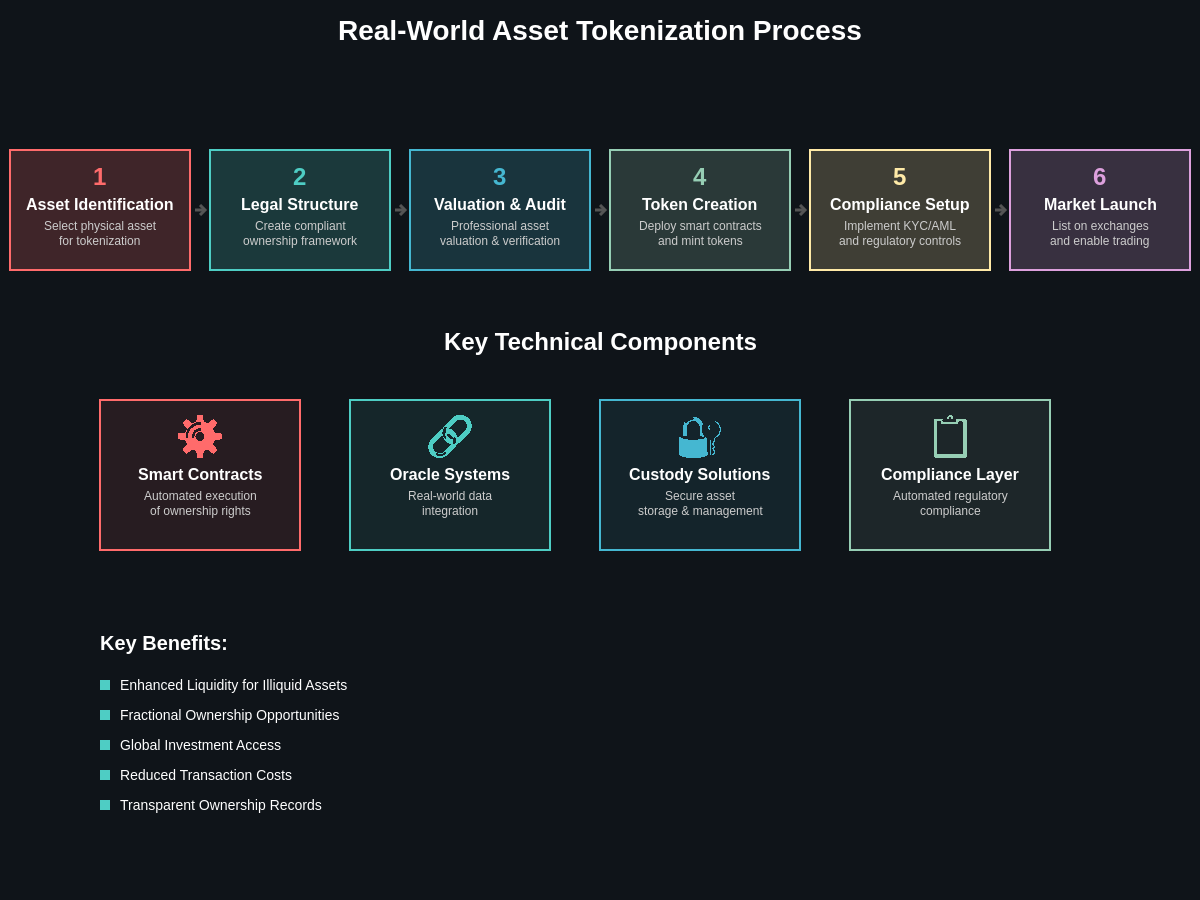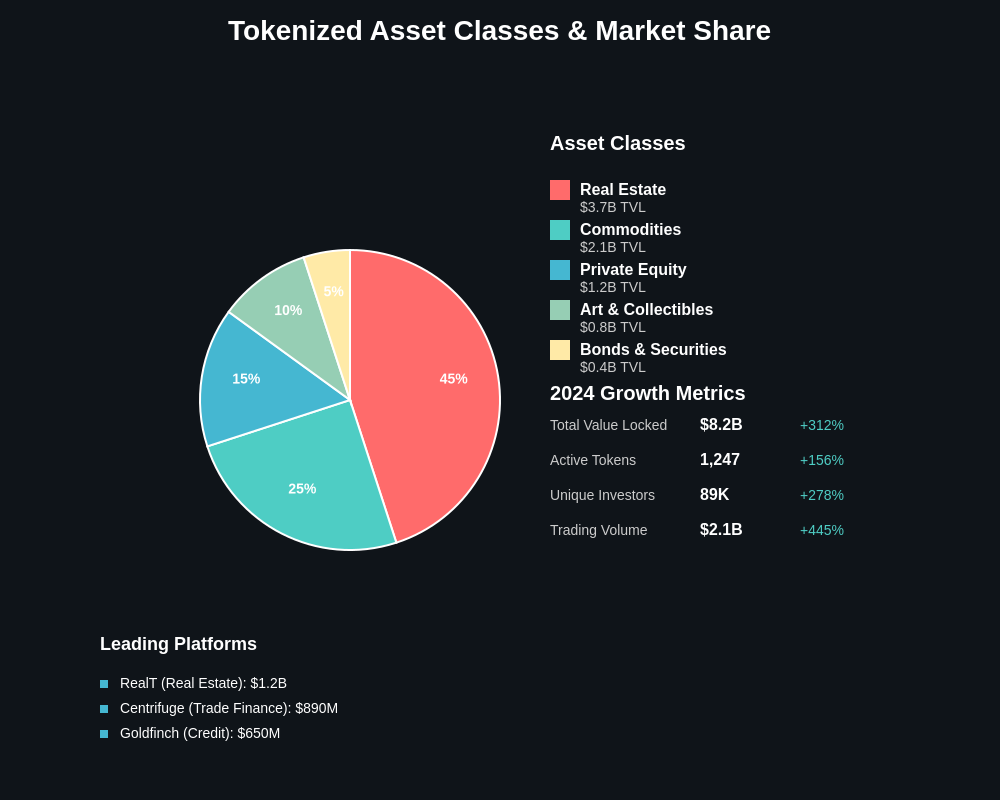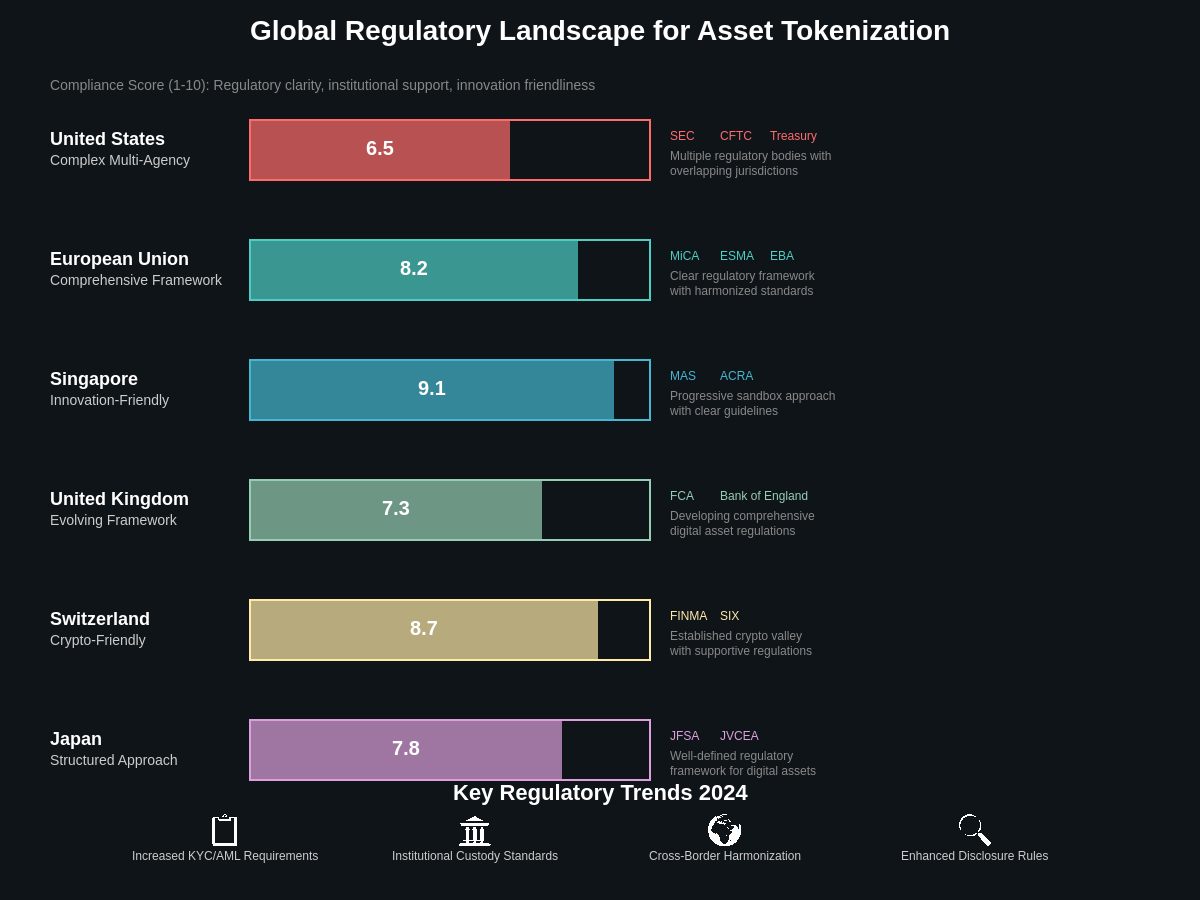The transformation of traditional financial markets through blockchain technology has reached a pivotal moment with the emergence of real-world asset tokenization, a revolutionary process that converts physical and digital assets into blockchain-based tokens that can be traded, fractionalized, and managed through smart contracts. This innovative approach to asset representation is fundamentally reshaping how we think about ownership, liquidity, and access to investment opportunities across multiple asset classes including real estate, commodities, art, intellectual property, and financial instruments.
Real-world asset tokenization represents more than a simple digitization of existing assets; it embodies a paradigm shift toward programmable ownership that enables previously illiquid assets to be divided into smaller, tradeable units while maintaining transparent, immutable records of ownership and transaction history. The integration of traditional assets with blockchain infrastructure creates new possibilities for global investment participation, enhanced liquidity, and reduced barriers to entry for both institutional and retail investors.
The market for tokenized real-world assets has experienced exponential growth throughout 2024, with total value locked exceeding $8 billion across various protocols and platforms, demonstrating strong institutional adoption and regulatory clarity in key jurisdictions. Major financial institutions, including BlackRock, JPMorgan, and Goldman Sachs, have launched tokenization initiatives while regulatory frameworks in the United States, European Union, and Singapore provide clearer guidance for compliant asset tokenization programs.

TradingView’s real-world asset tokenization data shows significant correlation between traditional asset performance and their tokenized counterparts, indicating successful price discovery mechanisms and market integration across different blockchain networks and traditional financial systems.
Historical Context and Market Evolution
The concept of asset tokenization emerged from early blockchain experiments with colored coins and meta-protocols that attempted to represent external assets on cryptocurrency networks, though these early implementations lacked the sophisticated smart contract capabilities and regulatory frameworks necessary for institutional adoption. The development of programmable blockchain platforms, particularly Ethereum, provided the technical foundation for more complex tokenization schemes that could encode ownership rights, distribution mechanisms, and compliance requirements directly into smart contract code.
Early tokenization efforts focused primarily on high-value, illiquid assets such as fine art and real estate, where the benefits of fractionalization and enhanced liquidity were most apparent to investors and asset owners. These pioneering projects demonstrated the feasibility of representing complex ownership structures on blockchain networks while highlighting the regulatory and technical challenges associated with bridging traditional legal frameworks with decentralized systems.
The evolution of tokenization standards, including ERC-20, ERC-721, and ERC-1400, provided standardized approaches to representing different types of assets and ownership structures on blockchain networks. These standards enabled interoperability between different platforms and applications while establishing common practices for asset representation, transfer mechanisms, and compliance integration that could accommodate varying regulatory requirements across different jurisdictions.
Institutional adoption of tokenization accelerated significantly following the development of permissioned blockchain networks and hybrid architectures that could satisfy regulatory requirements for investor accreditation, anti-money laundering compliance, and jurisdictional restrictions. These developments enabled traditional financial institutions to experiment with tokenization while maintaining compliance with existing regulatory frameworks and fiduciary responsibilities.
The maturation of decentralized finance protocols provided additional infrastructure for tokenized assets, including automated market makers, lending protocols, and yield farming mechanisms that could generate returns on tokenized real-world assets. This DeFi integration created new opportunities for asset owners to generate yield while providing investors with sophisticated strategies for portfolio construction and risk management across tokenized asset classes.
Technical Infrastructure and Blockchain Architecture
The technical architecture underlying real-world asset tokenization involves complex interactions between blockchain networks, oracle systems, custody solutions, and traditional financial infrastructure to create seamless bridges between physical assets and digital representations. Smart contracts serve as the primary mechanism for encoding asset characteristics, ownership rights, and operational parameters while ensuring compliance with relevant legal and regulatory requirements through programmable restrictions and automated enforcement mechanisms.
Oracle networks play a critical role in tokenization systems by providing reliable, tamper-resistant data feeds that connect blockchain networks with external information sources including asset valuations, market prices, regulatory updates, and operational data from asset managers and custodians. The accuracy and reliability of oracle data directly impacts the functionality and security of tokenized assets, making oracle selection and configuration crucial considerations for tokenization projects.
Custody solutions for tokenized real-world assets require sophisticated approaches that address both digital asset security and traditional asset safekeeping, often involving partnerships between blockchain-native custody providers and established financial institutions with expertise in specific asset classes. These hybrid custody models must accommodate the unique requirements of different asset types while maintaining the security and operational efficiency expected by institutional investors.
TradingView’s blockchain infrastructure analysis demonstrates the relationship between network scalability, transaction costs, and tokenization adoption rates, showing how layer-2 solutions and alternative blockchain architectures are reducing barriers to tokenization across different asset classes and investment sizes.
The integration of identity and compliance systems within tokenization platforms requires sophisticated approaches to know-your-customer verification, accredited investor status confirmation, and ongoing compliance monitoring that can operate across multiple jurisdictions while maintaining privacy and security for participants. These systems often employ zero-knowledge proof technologies and privacy-preserving computation methods to enable compliance verification without exposing sensitive personal or financial information.

Interoperability between different blockchain networks and tokenization platforms has become increasingly important as the ecosystem matures, with cross-chain protocols and bridge technologies enabling tokenized assets to move between different networks while maintaining their characteristics and compliance properties. This interoperability expands the potential market for tokenized assets while reducing fragmentation and improving liquidity across different platforms and ecosystems.
Asset Classes and Tokenization Applications
Real estate tokenization has emerged as one of the most prominent applications of blockchain-based asset representation, enabling property owners to fractionalize ownership stakes while providing investors with access to previously inaccessible commercial and residential properties across global markets. Tokenized real estate platforms facilitate investment in everything from commercial office buildings and retail centers to residential developments and industrial facilities, with smart contracts managing rental income distribution, property management decisions, and exit strategies.
The tokenization of commodity assets, including precious metals, agricultural products, and energy resources, creates new opportunities for portfolio diversification and hedging strategies that were previously available only to institutional investors with significant capital requirements. Commodity tokenization platforms often integrate with physical storage facilities and verification systems to ensure that digital tokens are backed by actual physical assets while providing transparent supply chain tracking and quality assurance mechanisms.
Art and collectibles tokenization has gained significant traction among high-net-worth individuals and institutional collectors seeking to monetize their collections while retaining ownership interests and curatorial control. These tokenization schemes often incorporate sophisticated governance mechanisms that allow token holders to participate in decisions regarding conservation, exhibition, and eventual sale of artworks while providing creators and artists with new revenue streams and fan engagement opportunities.
Financial instrument tokenization encompasses a broad range of traditional securities, debt instruments, and structured products that benefit from blockchain-based representation through enhanced transparency, automated compliance, and programmable distribution mechanisms. Tokenized bonds, for example, can incorporate automatic coupon payments, maturity handling, and secondary market trading capabilities directly into smart contract code while maintaining compliance with securities regulations and investor protection requirements.
Intellectual property tokenization represents an emerging frontier that enables creators, inventors, and content producers to monetize their intellectual assets through fractionalized ownership structures and automated royalty distribution systems. Patent holders can tokenize their intellectual property portfolios to raise capital for research and development while providing investors with exposure to innovation-driven returns through transparent, programmable revenue sharing mechanisms.
Carbon credit and environmental asset tokenization has gained momentum as organizations seek transparent, verifiable methods for tracking and trading environmental impact mitigation efforts. Tokenized carbon credits incorporate verification data from environmental monitoring systems and third-party certification bodies to ensure that digital tokens represent genuine environmental benefits while enabling automated compliance with corporate sustainability requirements and regulatory mandates.

Regulatory Landscape and Compliance Frameworks
The regulatory environment for real-world asset tokenization varies significantly across jurisdictions, with some regions providing clear frameworks for compliant tokenization while others maintain restrictive or unclear policies that limit innovation and adoption. The United States has developed a complex regulatory landscape involving multiple agencies including the Securities and Exchange Commission, Commodity Futures Trading Commission, and Treasury Department, each with jurisdiction over different aspects of tokenization depending on the underlying asset characteristics and investor participation structures.
European Union regulatory initiatives, particularly the Markets in Crypto-Assets regulation and proposed frameworks for digital asset services, provide more comprehensive approaches to tokenization that attempt to balance innovation promotion with investor protection and market integrity concerns. These frameworks establish clear requirements for tokenization platforms, asset custody, investor disclosure, and cross-border operations while providing regulatory certainty that enables institutional participation and investment.
Singapore has emerged as a leading jurisdiction for asset tokenization through progressive regulatory sandboxes and clear guidance from the Monetary Authority of Singapore regarding digital asset services and tokenized securities offerings. The Singapore approach emphasizes regulatory clarity and proportionate compliance requirements that accommodate both retail and institutional participation while maintaining robust investor protection and anti-money laundering standards.
TradingView’s regulatory impact analysis tracks the correlation between regulatory announcements and tokenization market activity, demonstrating how regulatory clarity drives institutional adoption and investment flows across different asset classes and geographical regions.
Compliance technology solutions for tokenized assets have evolved to address the complex requirements of multi-jurisdictional operations, incorporating automated know-your-customer verification, sanctions screening, tax reporting, and regulatory filing capabilities directly into tokenization platforms. These solutions enable tokenization projects to maintain compliance across multiple jurisdictions while reducing operational complexity and regulatory risk for both issuers and investors.
The development of international standards and cooperation frameworks for asset tokenization represents an important trend toward harmonizing regulatory approaches and reducing compliance complexity for global tokenization initiatives. Organizations including the Financial Action Task Force, International Organization of Securities Commissions, and Basel Committee on Banking Supervision are developing guidance and standards that could facilitate cross-border tokenization while maintaining appropriate regulatory oversight and investor protection.

Economic Impact and Market Dynamics
The economic implications of real-world asset tokenization extend beyond simple digitization to encompass fundamental changes in market structure, liquidity provision, and price discovery mechanisms that affect both tokenized assets and their traditional counterparts. Tokenization reduces barriers to investment participation by enabling fractional ownership and lower minimum investment requirements, potentially democratizing access to asset classes that were previously available only to institutional investors or high-net-worth individuals.
Liquidity enhancement represents one of the most significant economic benefits of asset tokenization, as previously illiquid assets such as real estate, private equity, and art can be traded more efficiently through blockchain-based platforms with reduced transaction costs and settlement times. This enhanced liquidity can increase asset valuations while providing owners with more flexible exit strategies and portfolio management options that were not available through traditional investment structures.
Market efficiency improvements through tokenization include enhanced price discovery mechanisms enabled by continuous trading capabilities, transparent transaction history, and reduced information asymmetries between buyers and sellers. Blockchain-based asset representation provides immutable records of ownership transfers, asset performance, and relevant market data that can improve investment decision-making and risk assessment across different asset classes and market conditions.
The integration of tokenized assets with decentralized finance protocols creates new opportunities for yield generation, portfolio leverage, and sophisticated investment strategies that combine traditional asset exposure with cryptocurrency market dynamics. Investors can use tokenized real estate as collateral for DeFi lending protocols while earning yield from rental income, creating compound return opportunities that were not available through traditional investment vehicles.
Cross-border investment facilitation through tokenization reduces friction and costs associated with international asset allocation, enabling global diversification strategies that were previously limited by regulatory complexity, currency conversion costs, and operational challenges. Tokenized assets can be traded across jurisdictions more efficiently while maintaining compliance with local regulations through programmable restrictions and automated compliance mechanisms.
The emergence of tokenized asset indices and structured products provides institutional investors with diversified exposure to tokenization markets while reducing the complexity and due diligence requirements associated with individual asset selection. These products combine multiple tokenized assets across different classes and geographies to create risk-adjusted return profiles that meet institutional investment criteria and fiduciary requirements.
Technology Integration and Infrastructure Development
The technological infrastructure supporting real-world asset tokenization continues to evolve rapidly, with improvements in blockchain scalability, interoperability, and user experience driving broader adoption across different asset classes and investor segments. Layer-2 scaling solutions and alternative blockchain architectures are reducing transaction costs and processing times for tokenized asset operations while maintaining the security and decentralization properties that make blockchain-based asset representation attractive to institutional investors.
Integration with traditional financial infrastructure requires sophisticated approaches to connectivity between blockchain networks and existing banking, custody, and settlement systems that handle trillions of dollars in daily transaction volume. These integration efforts often involve the development of hybrid architectures that can operate across both blockchain and traditional systems while maintaining compliance, security, and operational efficiency requirements from both domains.
Artificial intelligence and machine learning technologies are increasingly integrated into tokenization platforms to enhance asset valuation, risk assessment, and portfolio optimization capabilities for both individual assets and diversified tokenized asset portfolios. These technologies can analyze market data, asset performance, and macroeconomic indicators to provide investors with sophisticated analytics and decision support tools that improve investment outcomes and risk management effectiveness.
TradingView’s technology integration metrics show correlation between technology adoption rates and tokenization market growth, demonstrating how improvements in user experience, security, and operational efficiency drive broader market participation and institutional investment flows.
Internet of Things integration with tokenized physical assets enables real-time monitoring and data collection that can enhance asset management, performance tracking, and compliance verification for tokenization projects. Smart sensors and monitoring devices can provide continuous data streams about asset condition, utilization, and performance that feed into smart contracts and oracle systems to enable automated management and optimization decisions.
Quantum-resistant cryptography and advanced security measures are being implemented across tokenization platforms to address long-term security concerns and maintain investor confidence as quantum computing capabilities advance. These security enhancements ensure that tokenized assets and their associated smart contracts remain secure against future technological developments while maintaining backward compatibility with existing systems and investments.
Market Participants and Ecosystem Development
The tokenization ecosystem encompasses a diverse range of participants including asset originators, technology platforms, financial intermediaries, regulatory specialists, and infrastructure providers that collectively enable the creation, management, and trading of tokenized real-world assets. Traditional financial institutions are increasingly participating in tokenization markets through direct investment, platform development, and partnership arrangements with blockchain-native companies that provide specialized tokenization capabilities.
Asset management companies have emerged as key participants in tokenization markets, developing specialized funds and investment vehicles that focus exclusively on tokenized assets while providing institutional investors with professional management and due diligence capabilities. These asset managers often combine traditional investment expertise with blockchain technology knowledge to create sophisticated investment strategies that maximize the benefits of tokenization while managing associated risks and operational complexities.
Technology platform providers serve as critical infrastructure components in the tokenization ecosystem, offering comprehensive solutions for asset tokenization, compliance management, investor onboarding, and secondary market trading. These platforms often specialize in specific asset classes or geographical regions while providing standardized approaches to tokenization that reduce complexity and costs for asset owners seeking to tokenize their holdings.
Legal and regulatory service providers play essential roles in tokenization projects by structuring compliant ownership frameworks, navigating multi-jurisdictional regulatory requirements, and ensuring that tokenization schemes satisfy applicable securities laws and investor protection requirements. These specialists often work closely with technology providers to implement compliance capabilities directly into smart contracts and platform architectures.
Custodial service providers have developed specialized capabilities for tokenized assets that address both digital asset security and traditional asset safekeeping requirements, often involving partnerships between established financial institutions and blockchain-native custody solutions. These hybrid custody models enable institutional investors to participate in tokenization markets while maintaining the security and operational standards required by their fiduciary responsibilities and regulatory obligations.
Market makers and liquidity providers facilitate efficient trading of tokenized assets by providing continuous bid and offer prices, managing inventory risk, and enabling smooth price discovery mechanisms across different trading platforms and market conditions. These participants often employ sophisticated algorithmic trading strategies and risk management techniques to maintain market efficiency while generating returns from spread capture and inventory management activities.
Future Outlook and Industry Predictions
The trajectory of real-world asset tokenization suggests continued rapid growth driven by improving regulatory clarity, technological infrastructure development, and increasing institutional adoption across multiple asset classes and geographical regions. Industry analysts project that the tokenized asset market could exceed $50 billion in total value by 2026, with real estate, commodities, and private equity representing the largest segments by market capitalization and trading volume.
Central bank digital currency development and stablecoin integration with tokenization platforms are expected to enhance the efficiency and accessibility of tokenized asset markets by providing stable, programmable payment mechanisms that can operate seamlessly with smart contract-based asset management systems. These developments could significantly reduce settlement times and currency conversion costs while enabling more sophisticated automated investment and portfolio management strategies.
Artificial intelligence integration with tokenization platforms is anticipated to revolutionize asset valuation, risk assessment, and portfolio optimization capabilities by analyzing vast amounts of market data, asset performance metrics, and macroeconomic indicators to provide investors with sophisticated decision support tools. Machine learning algorithms could enable dynamic pricing models, automated rebalancing strategies, and predictive analytics that improve investment outcomes while reducing management costs and operational complexity.
TradingView’s market prediction models indicate strong correlation between traditional asset performance and tokenized equivalents, suggesting that tokenization markets will increasingly reflect broader economic trends while potentially offering enhanced liquidity and accessibility benefits that could attract additional institutional and retail investment flows.
The expansion of tokenization into emerging markets and developing economies could provide significant opportunities for capital formation and investment access in regions where traditional financial infrastructure is limited or expensive. Blockchain-based asset tokenization could enable global investment participation in local assets while providing economic development benefits through improved capital allocation and reduced investment barriers.
Regulatory harmonization efforts and international cooperation frameworks are expected to reduce compliance complexity and facilitate cross-border tokenization initiatives that could significantly expand market opportunities while maintaining appropriate investor protection and market integrity standards. These developments could enable the creation of global tokenized asset markets that operate efficiently across multiple jurisdictions while satisfying local regulatory requirements.
Challenges and Risk Considerations
Despite significant progress in technology and regulatory frameworks, real-world asset tokenization faces substantial challenges including technological complexity, regulatory uncertainty, market fragmentation, and operational risks that must be addressed for broader institutional adoption and market maturation. Smart contract vulnerabilities and blockchain network security concerns represent ongoing technical risks that could affect tokenized asset security and investor confidence, requiring continuous security auditing and improvement efforts across tokenization platforms and infrastructure providers.
Regulatory compliance across multiple jurisdictions creates complex operational requirements for tokenization projects that must satisfy varying securities laws, tax regulations, and investor protection standards while maintaining efficient operations and competitive cost structures. The evolving nature of regulatory frameworks for digital assets creates uncertainty that can limit institutional participation and investment commitment until clearer, more stable regulatory environments emerge.
Market liquidity challenges persist for many tokenized assets, particularly those representing illiquid underlying assets or operating in nascent markets with limited participant bases and trading activity. The success of tokenization depends heavily on developing sufficient market depth and trading volume to provide meaningful liquidity benefits compared to traditional investment alternatives, which may require significant time and market development efforts.
Asset custody and security considerations for tokenized real-world assets involve complex arrangements that must address both digital asset security and traditional asset protection, often requiring coordination between multiple service providers and custody arrangements that can introduce operational complexity and potential security vulnerabilities. The hybrid nature of tokenized asset custody creates unique risk profiles that require specialized expertise and risk management approaches.
Price volatility and correlation risks associated with tokenized assets can be influenced by both underlying asset performance and broader cryptocurrency market dynamics, potentially creating unexpected portfolio risk exposures for investors who may not fully understand the interaction between traditional asset fundamentals and blockchain market forces. These correlation risks require sophisticated risk management approaches and investor education to ensure appropriate investment decision-making.
Technology adoption barriers including user experience complexity, integration challenges with existing financial systems, and limited availability of sophisticated trading and portfolio management tools can restrict institutional adoption and market growth until more mature and user-friendly solutions become widely available across different market segments and investor types.
Disclaimer
This article is for informational purposes only and does not constitute financial, investment, legal, or tax advice. Real-world asset tokenization and cryptocurrency investments involve significant risks including potential loss of capital, regulatory uncertainty, market volatility, and technological risks. The tokenization market is rapidly evolving with changing regulatory requirements and technological developments that may affect investment outcomes. Past performance of tokenized assets or related investments does not guarantee future results. Investors should conduct thorough due diligence and consult with qualified financial, legal, and tax professionals before making any investment decisions involving tokenized real-world assets or related blockchain technologies. The information presented in this article may become outdated and should be verified with current sources before making any financial decisions.